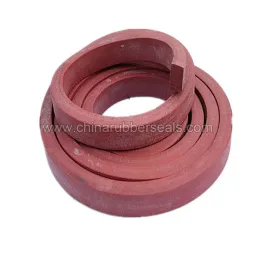What Are Rubber Strips Used for?
Rubber strips are a versatile material that finds application in various industries and settings. They are used for a wide range of purposes, including seals, gaskets, and more.
The origin of rubber strips can be traced back to the natural rubber tree, which produces a sticky latex that can be processed into a versatile material. The rubber industry has since developed various processes to create different grades and shapes of rubber strips for specific applications.

Process of using rubber strips:
The process of using rubber strips involves several steps. First, the user identifies the appropriate grade and shape of rubber strip for the intended application. This step requires knowledge of the material properties and characteristics required for the specific application.
Next, the user removes any protective covers or films from the rubber strip and inspects it for any damage or imperfections. If any are found, they should be noted and the rubber strip replaced or repaired.
Rubber & Plastics
Exploring the Benefits of Flexible Hydraulic Hoses
Sungda Conveyor Belt Co.,Ltd.
5 Reasons Why Your Business Needs how is rubber processed?
Get the Best Germany Standard Hydraulic Hose Quotes Now!
What are the top 10 tips for choosing the best sae100r2 hose at the purchase stage?
Exploring the Different Types of Hoses
Once the rubber strip is ready for use, it is installed in the desired location. This step may involve cutting the strip to the correct length or shaping it to fit into a specific groove or opening. The user should ensure that the rubber strip is securely fastened in place and does not move or shift during operation.
Significance and impact of rubber strips:
Rubber strips play a crucial role in various industrial and domestic settings. They provide effective sealing solutions, reducing air leakage, noise, and heat transfer in areas such as doors, windows, and mechanical systems. Rubber strips also act as shock absorbers, protecting sensitive components from damage due to vibrations or impacts.
In addition to their sealing and shock-absorbing properties, rubber strips have excellent chemical resistance, making them suitable for use in environments with harsh chemicals or high temperatures. They also provide a non-corrosive and non-conductive material, reducing the risk of electrical short circuits or chemical reactions in sensitive electronic components.
The impact of rubber strips extends beyond their practical applications. They are also important in reducing energy consumption by providing efficient sealing solutions that prevent heat loss and air leakage. This contributes to a more energy-efficient building envelope and reduces the environmental impact of energy consumption.
In conclusion, rubber strips are a versatile material used for various sealing, shock-absorbing, and protective applications. Their origin can be traced back to the natural rubber tree, and their significance and impact are felt across various industries and domestic settings. By providing efficient sealing solutions and protecting sensitive components, rubber strips contribute to overall system efficiency, safety, and environmental sustainability.
Which Hydraulic Hose is Superior: SAE 100 R12?
Revolutionizing the Automotive Industry with Hose Innovations: Which Brands are Leading the Charge?
Top Tips for Maintaining Your Car's AC
Revolutionizing Hydraulic Hoses: Is SAE 100R12 the Future of Industry?
How do I select an EN853 compliant hydraulic hose?
Mastering the Hydraulic Hose Manufacturing Process: Insider Tips!
Top Tips for Choosing OEM Steel Wire Braided Hydraulic Hose Cover







